Bone and soft tissue grafting are surgical procedures that involve transplanting healthy bone or soft tissue from one part of the body to another. These procedures are typically used to restore missing or damaged bone or soft tissue in the mouth, jaw, or face.
At Philadelphia Oral & Maxillofacial Surgery, Dr. Nguyen and her team use the latest techniques and dental technology to perform bone and soft tissue grafting procedures with the highest level of precision and safety.


There are many reasons to undergo a grafting procedure when necessary. Some of the significant benefits of bone and soft tissue grafts include:
There are several types of grafting procedures that may be recommended depending on your specific needs. Some of the most common types of bone grafting procedures include:
The most common types of soft tissue grafts include:
Before your grafting procedure, Dr. Nguyen and her team will have you attend an initial consultation. During your consultation, they’ll evaluate your oral health, discuss your goals and concerns, and develop a customized treatment plan. They’ll also review your medical history to ensure that there are no conditions or medications that could interfere with the grafting procedure. Your consultation is a great time to ask any questions or voice any concerns you may have.
You’ll be given preoperative instructions that include avoiding certain medications, fasting for a certain period, and arranging for transportation to and from the dental office. Once you arrive for the appointment, the surgical site will be sterilized to reduce the risk of infection.
We’ll apply a local anesthetic to the future surgical site to numb you to any pain. For patients who are feeling nervous or need extra help getting numb, we can offer sedation dentistry options. Once you’re numb, Dr. Nguyen will begin the grafting process.
For a soft tissue graft, the healthy soft tissue will be carefully placed into the damaged area and secured in place with sutures. For a bone graft, The bone graft will be carefully placed into the damaged area of the jawbone and secured in place with screws, pins, or wires. The incision will be closed using stitches or surgical staples.


The best way to ensure the success of your graft is to follow the instructions given by your oral surgeon. Some common aftercare instructions for both bone and soft tissue grafting procedures include the following:
It's important to note that these instructions may vary depending on the specific type of grafting procedure you have undergone and your individual healing needs. Always follow the specific aftercare instructions provided by your healthcare provider to ensure the best possible outcome.
Looking to restore the health, function, and aesthetics of your smile? Bone and soft tissue grafts are advanced oral surgical procedures that can help. At Philadelphia Oral & Maxillofacial Surgery, our experienced team, led by Dr. Cyndi Nguyen offers gum and bone grafting procedures using the latest techniques and technology to ensure optimal outcomes for our patients.
If you're interested in learning more about how grafting procedures can benefit you, we invite you to schedule a consultation with Philadelphia Oral & Maxillofacial Surgery by dialing 215-273-3223. We serve new and returning patients from Philadelphia and surrounding areas such as Springfield, Kensington, and Levittown, PA.